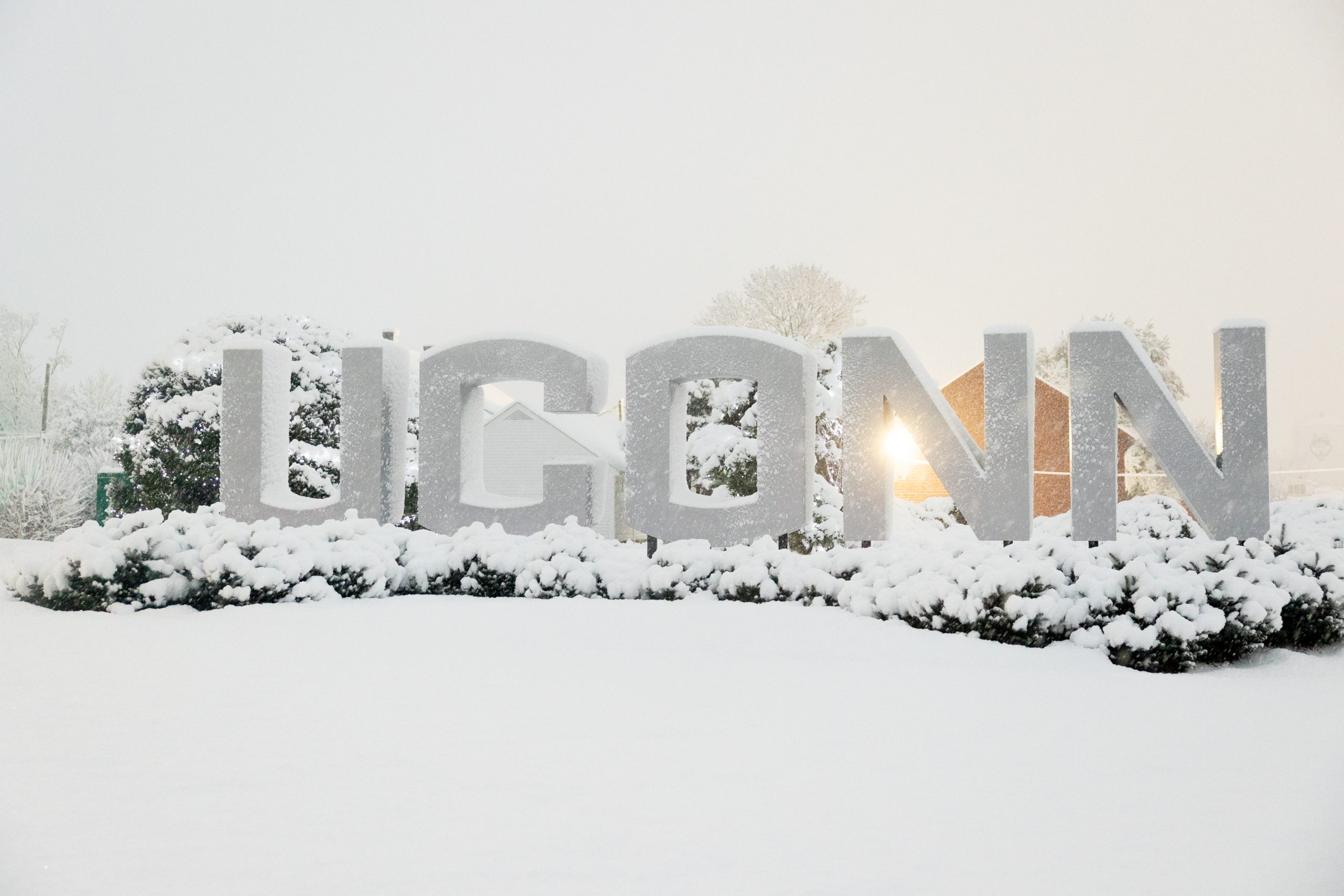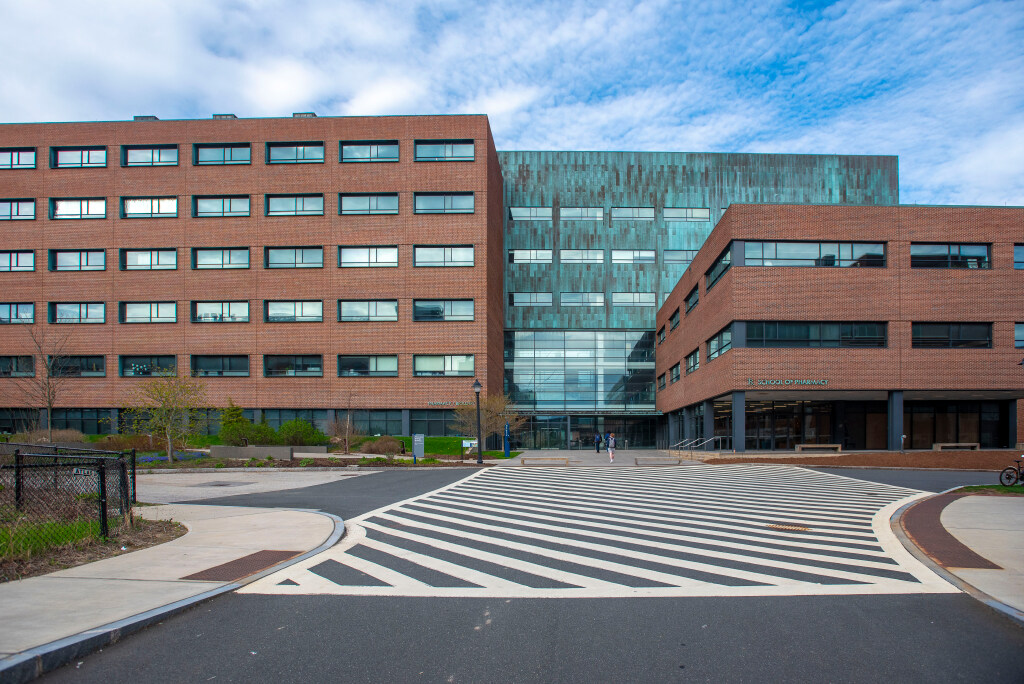 Dr. Maria Chrysochoou, an assistant professor of Civil & Environmental Engineering, oversees the efforts of two graduate students and three undergraduate environmental engineering students who are conducting research aimed at remediating chromium-contaminated soil at the site of National Chromium, a metal plating operation in Putnam, CT.
Dr. Maria Chrysochoou, an assistant professor of Civil & Environmental Engineering, oversees the efforts of two graduate students and three undergraduate environmental engineering students who are conducting research aimed at remediating chromium-contaminated soil at the site of National Chromium, a metal plating operation in Putnam, CT.
The undergraduate students – Kathryn Shinkiewicz, James Honda and Matthew Quaranta – are benefitting from the exceptional learning opportunity to engage in real-world research. About 10 percent of engineering seniors participate in research underway in faculty laboratories. For environmental engineering majors, the culminating senior design challenge may involve original research. In Dr. Chrysochoou’s view, the value of lab research is “200 percent for undergraduates. It gives them a completely different perspective to carry out research on a real problem.” The combination of lab research and guidance provided by industry sponsor, Dr. Lucas Hellerich of Metcalf & Eddy, exposes the students to a suite of future career paths.
Ms. Shinkiewicz agreed. “Working on this real-life project allows us to become familiar with the engineering career world. It has taught me how much detail and time must go into each project, of which some companies complete hundreds in a year. . .the experimental work, which is imperative to the final report, is very trial-and-error.”
For their senior design project, the three seniors first established the state of the art in chromium remediation and familiarized themselves with the contaminated site during the fall ’08 term. The three will complete their team project and also examine a particular aspect of the problem individually for their theses. They are now embarking on the actual testing phase of their projects in Dr. Chrysochoou’s lab.
According to Ms. Shinkiewicz, the project involves the development of a “site-specific solution to soil and groundwater contamination by hexavalent chromium. The traditional remediation method is to excavate the contaminated soil, place it in sealed 55 gallon drums, and then store the drums at an appropriate hazardous waste facility or landfill.” Hexavalent chromium (Cr VI), which is both highly toxic and a known cancer-causing agent, is used commonly in leather tanning, metal plating, cement manufacture and other industries. Cr VI was the pollutant at the heart of the “Erin Brockovich” case, though trivalent chromium (Cr III) is required by humans for sugar metabolism.
The National Chromium Company released quantities of chromium into the surrounding soil and groundwater for decades, before the dangers of Cr VI were known. In 1988, EPA flagged the site for severe contamination in the soil and air, and for a wastewater treatment operation that failed to meet regulations. National Chromium forged a consent decree with the Connecticut Department of Environmental Protection that involved construction of a new building; installation of a pump-and-treat well that collects the contaminated water from the surrounding area and recycles it into the plant for operations; and contracting with consultants from UConn and Metcalf & Eddy on ways to remediate the soil contamination beneath the building. The company is now considered a success story for its proactive steps in correcting the contamination problems.
Dr. Chrysochoou became involved in the project in 2007. She explained that the site offers numerous challenges for her team, which also includes graduate students Chad Johnston and Aaron Ting. The group is looking at a host of variables: the soil type, pH and conductivity; quantity and concentration of Cr VI found in the soil; how the Cr VI is bound with the soil; groundwater flow rate and direction; and the reaction rate between Cr VI and the remediating compound, among other things. The team is focusing on two possible remediation protocols: calcium polysulfide and nano zero-valent iron. Both have been found to have success in lab settings, where they react with the Cr VI, converting it to Cr III.
The undergraduate team project involves the injection of calcium polysulfide (CPS) into the contaminated soil. Mr. Quaranta said, “Our current research is aimed at determining the aspects of CPS injection. Since data on in situ CPS injection are scarce, there are many unknowns. We are in the process of setting up a column study where we will inject CPS into several soil columns under varying conditions to optimize its effectiveness and test the effects on soil biogeochemistry.” Site core samples will be tested in the laboratory. Dr. Chrysochoou said “One major objective is to determine the optimal location and number of injection sites that can be placed upstream from the building. We expect the CPS will be transported by the groundwater to the location of the Cr VI contamination.”
In addition to the group project, each student is investigating a thesis individually. Ms. Shinkiewicz’s thesis focuses on the use of nano zero-valent iron (nZVI). “With assistance from other students in the lab, I will be running soil columns packed with site soil and monitoring the remedial effects of an nZVI solution injected through the column. My goal is to learn whether nZVI can reduce the concentration of Cr VI in the soil to below state regulations, and how much time would be required.”
“The question I will address,” said Mr. Honda, “relates to the solid reaction products that will form as the chromium and other soil components are reduced by the reductant solutions. I will investigate how these products may alter the hydraulic conductivity, essentially the flow of water, through the soil column. If the hydraulic conductivity is significantly changed, it could have an impact on the effectiveness of the remediation treatment. I will be utilizing manometer readings from side ports drilled in the columns to determine differences in pressure head throughout the soil column.”
 Mr. Quaranta will evaluate, and possibly propose an updated version of, two EPA standard tests (3060A and 7196a) that are used to quantify the amount of Cr VI in a soil sample. “The method is always successful in the lab except when we test samples that have been treated with CPS. Treated samples fail to produce a reading, for unknown reasons. This problem is not addressed in the standard method because, when the test was made (1992), the idea of treating chromium samples with CPS had not been considered. My goal is to find out why the tests fail and hopefully be able to figure out a way to modify the tests in order to get accurate results.”
Mr. Quaranta will evaluate, and possibly propose an updated version of, two EPA standard tests (3060A and 7196a) that are used to quantify the amount of Cr VI in a soil sample. “The method is always successful in the lab except when we test samples that have been treated with CPS. Treated samples fail to produce a reading, for unknown reasons. This problem is not addressed in the standard method because, when the test was made (1992), the idea of treating chromium samples with CPS had not been considered. My goal is to find out why the tests fail and hopefully be able to figure out a way to modify the tests in order to get accurate results.”
The students will deliver a formal presentation on their research and conclusions in the spring. According to Mr. Quaranta, the team will present what they judge to be the best remediation approach for the contaminated site, a solution that may also recommend the use of a cap on the soil to prevent infiltration of rainwater.
Dr. Chrysochoou, who received her Ph.D. in environmental engineering from Stevens Institute of Technology, Hoboken, NJ (2006), is involved in various aspects of heavy metal speciation and remediation, contaminated site remediation, recycling and reuse of industrial wastes and geotechnical stabilization of expansive soils and waste. Her post-doctoral research involved in-depth examination of dredged material stabilization with industrial byproducts, treatment of chromite ore processing residue, and munitions remediation. In addition to the National Chromium site, Dr. Chrysochoou is also engaged in expanding her current work to remediation efforts at Department of Energy and Department of Defense facilities, where Cr VI is a frequent contaminant. She also collaborates with the cement and energy industries to reuse and recycle waste from their ongoing operations.
With a focus on mineralogical characterization and heavy metal contamination, Dr. Chrysochoou relies on a host of techniques and high-tech apparatuses to tease out the components of a contaminated sample including X-ray powder diffraction, optical microscopy, scanning electron microscopy/energy dispersive X-ray, electron probe microanalysis, and X-ray absorption spectroscopy. The most potent weapon in her arsenal is a synchrotron advanced light source at the Lawrence Berkeley National Lab, a subatomic particle accelerator the size of a football field that she said is capable of determining the valance state of particles and characterizing how a contaminant is bound to soil particles. A new collaboration with the Stanford Synchrotron Radiation Laboratory is also upcoming, and both Dr. Chrysochoou and her graduate students are excited by the opportunity to travel to California and spend 24-hour days in the round-the-clock experimental facility.


